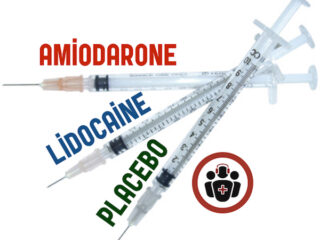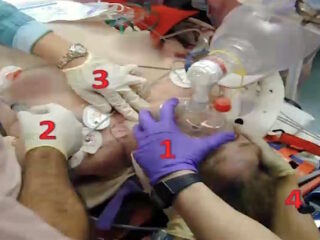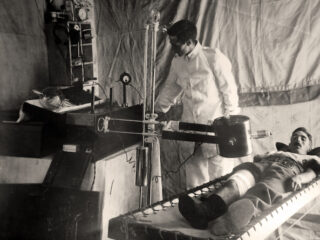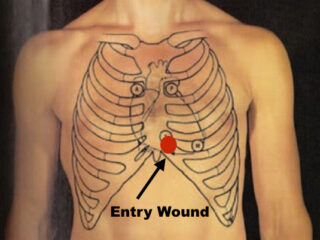Most Recent
Journal Jam 7 – Amiodarone vs Lidocaine vs Placebo in Cardiac Arrest: The ALPS Trial
Journal Jam 7 - Amiodarone vs Lidocaine vs Placebo in Cardiac Arrest: The ALPS Trial. In our most popular EM Cases episode to date - ACLS Guidelines Cardiac Arrest Controversies, we boldly stated, that there has never been an antiarrhythmic medication that has shown any long term survival benefit in cardiac arrest. The use of medications in cardiac arrest has been one of those things that we all do, but that we know the evidence isn’t great for. Yet Amiodarone is still in the newest AHA adult cardiac arrest algorithm for ventricular fibrillation or pulseless ventricular tachycarida – 300mg IV after the 3rd shock with the option to give it again at 150mg after that. Anti-arrhythmics have been shown in previous RCTs to increase the rate of return of spontaneous circulation and even increased survival to hospital admission, however none of them have been able to show a decrease in mortality or a favourable neurological outcome at hospital discharge. In other words, there has never been shown a long term survival or functional benefit - which is a bit disconcerting. But now, we have a recent large randomized, controlled trial that shines some new light on the role of anti-arrythmics in cardiac arrest - The ALPS trial: Amiodarone vs Lidocaine vs placebo in out of hospital cardiac arrest. In this Journal Jam podcast, Justin Morgenstern and Anton Helman interview two authors of the ALPS trial, Dr. Laurie Morrison a world-renowned researcher in cardiac arrest and Dr. Paul Dorian, a cardiac electrophysiologist and one of Canada's leading authorities on arrhythmias about what we should take away from the ALPS trial. It turns out, it's not so simple. We also discuss the value of dual shock therapy for shock resistant ventricular fibrillation and the future of cardiac arrest care.
Best Case Ever 47 – Cyanotic Infant
In anticipation of EM Cases' upcoming episode, Congenital Heart Disease Emergencies we have Dr. Gary Joubert a double certified Pediatric EM and Pediatric Cardiology expert telling his Best Case Ever of a four month old infant who presents with intermittent cyanosis. The Cyanotic Infant can present a significant challenge to the EM provider as the differential is wide, ranging from benign causes such as GERD to life threatening heart disease that may present atypically in a well-appearing child. Dr. Joubert gives us some simple sweet clinical pearls to help us along the way...
Episode 83 – 5 Critical Care Controversies from SMACC Dublin
EM Cases Episode 83 - 5 Critical Care Controversies from SMACC Dublin: I had the great opportunity to gather some of the brightest minds in Emergency Medicine and Critical Care from around the world (Mark Forrest from U.K., Chris Nickson from Australia, Chris Hicks from Canada and Scott Weingart from U.S.) at the SMACC Dublin Conference and ask them about 5 Critical Care Controversies and concepts: How to best prepare your team for a resuscitation Optimum fluid management in sepsis Direct vs. video laryngoscopy as first line tool for endotracheal intubation Early vs. late trauma intubation Whether or not to attempt a thoracotomy in non-trauma centres The discussion that ensued was enlightening...
Best Case Ever 46 – Chris Nickson on Hickam’s Dictum
EM Cases Best Case Ever - Chris Nickson on Hickam's Dictum. Usually we use the heuristic of Occam's razor to help us arrive at one diagnosis that makes sense of all the data points that a particular patient presents to us. However sometimes it's not so straight forward and we need to think about multiple diagnoses that explain a patient's condition - Hickam's Dictum. Dr. Chris Nickson, the brains behind the Life in the Fast Lane blog tells his Best Case Ever from the SMACC Conference in Dublin, in which a patient thrombolysed for massive pulmonary embolism suffers a cardiac arrest, and the thought process he went through to discover the surprising complicating diagnoses that ensue...
Episode 82 – Emergency Radiology Controversies
EM Cases Episode 82 Emergency Radiology Controversies, pearls and pitfalls: Which patients with chest pain suspected of ACS require a CXR? What CXR findings do ED docs tend to miss? How should we workup solitary pulmonary nodules found on CXR or CT? Is the abdominal x-ray dead or are there still indications for it's use? Which x-ray views are preferred for detecting pneumoperitoneum? When should we consider ultrasound as a screening test instead of, or before, CT? What are the indications for contrast in abdominal and head CT? How should we manage the patient who has had a previous CT contrast reaction who really needs a CT with contrast? What is the truth about CT radiation for shared decision making? And much more...
CritCases 3 – GSW to the Chest
EM Cases CritCases 3 - GSW to the chest in a rural setting. In this CritCases we discuss preparation for penetrating trauma in a rural setting, the ABC score, massive transfusion protocol, clamshell thoracotomy, trauma intubation and more. The Case... You are the transport physician on call. A 50-year old male with a history of depression allegedly shot himself in the chest with a rifle. A bystander called 911. The local paramedics are en route and the air transport team is activated with a plan to rendezvous at the nearest hospital, Janus General, which is 90 minutes by ground from the nearest tertiary care centre. You contact the rural hospital for a status update but all they can tell you is that his GCS is 14 and he has a GSW to the central chest.







